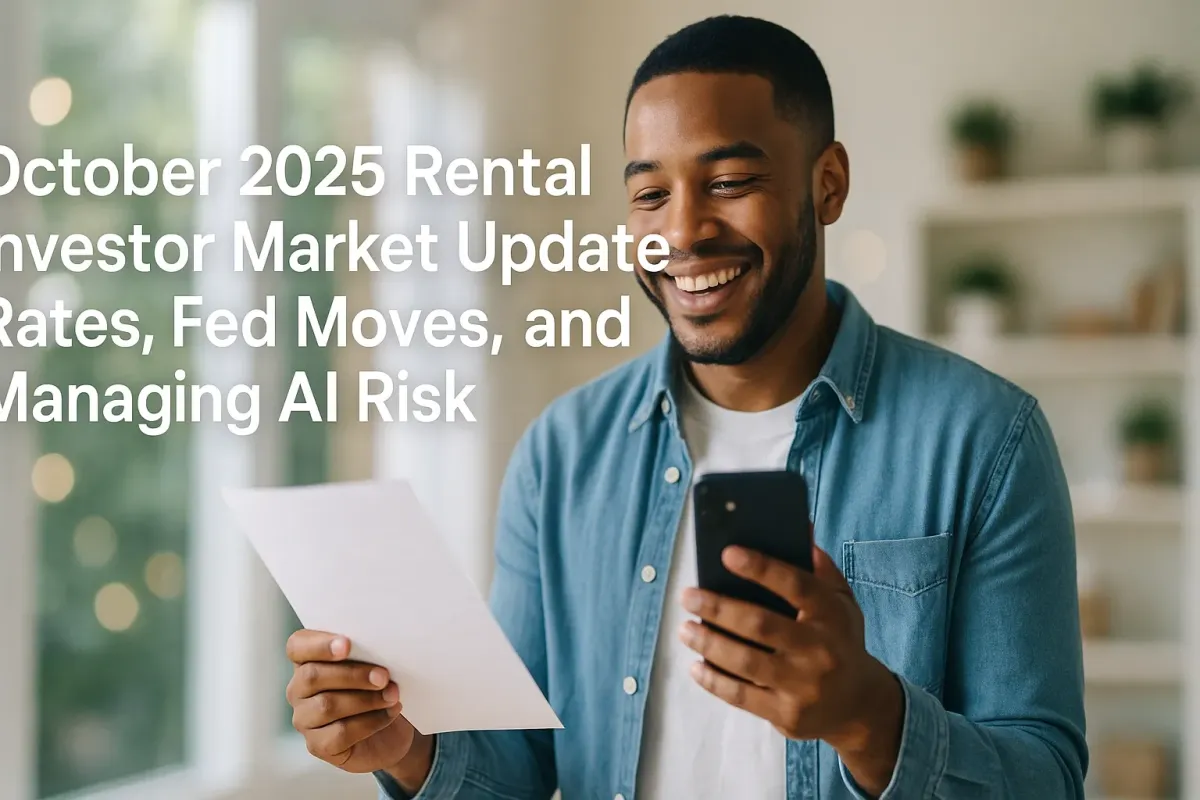
October Rental Investor Market Update
Rates, Fed Moves, and Managing AI Risk
The market just served up a mixed bag of opportunities and challenges for real estate investors. While the Fed delivered another rate cut, the underlying currents suggest we're entering uncharted territory where traditional economic playbooks might not apply.
Let's break down what happened this week and what it means for your investment strategy.
Current Rate Environment: The Numbers That Matter
Here's where we stand heading into November:
Current Rates (as of October 30, 2025):
5 Yr Treasury: 3.70%
30 Yr Fixed Rate Mortgage: 6.19%
30 Yr DSCR (Competitive): 6.98%
30 Yr DSCR (Market Average): 6.75%
Fix and Flip Financing: 10.25% and up
The gap between conventional mortgages and DSCR loans remains substantial at roughly 80 basis points. For investors, this spread represents the cost of flexibility – but it's a cost that could pay dividends as market conditions shift.
Fed's Latest Move: A 0.25% Cut With Strings Attached
The FOMC voted 10-2 to cut the Fed Funds Rate by 0.25% to a range of 3.75% to 4%. This was expected, but the devil's in the details.
The Split That Matters
Those two dissenting votes tell a story. One member wanted a bigger 0.5% cut, while another wanted no change at all. This isn't just procedural disagreement – it reflects genuine uncertainty about where the economy is heading.
Fed Chairman Powell made it crystal clear: "A further reduction to the policy rate at the December meeting is not a foregone conclusion."
Translation? Don't bet the farm on another December cut.
Why Powell's Playing It Cautious
Powell highlighted the tension between the Fed's dual mandate: "We saw a very different picture of the labor market that suggested there are higher risks to the labor market than we had thought...one goal (2% inflation) is calling for you to hike and one (full employment) is calling for you to cut."
The market heard this loud and clear. The 5 Yr Treasury jumped nearly 0.1% immediately after the announcement, signaling reduced confidence in a December rate cut.
The End of Quantitative Tightening: What It Means for Mortgage Rates
Here's the kicker many missed: the Fed announced it will end quantitative tightening effective December 1st. They're becoming buyers in the Treasury market again.
But – and this is crucial for real estate investors – they explicitly stated they won't reinvest principal repayments from agency mortgage-backed securities into new MBS holdings.
What This Means for You:
Wider credit spreads on mortgages
Potentially higher mortgage rates even if Treasury rates fall
DSCR and investment property loans could see particularly pronounced spread widening
December Rate Predictions: What the Smart Money Says
The Fed Funds Futures market is pricing in an 87% probability of another 0.25% cut at the December 10th meeting, down from 91.5% last week.
Current Odds for December:
No change (3.75% - 4%): 13% probability
0.25% cut (3.5% - 3.75%): 87% probability
These odds are already baked into current rates, so don't expect dramatic moves unless something changes materially.
The AI Employment Disruption: A New Risk Factor
We're witnessing something unprecedented: major corporations openly citing AI adoption as the driver behind large-scale layoffs. Amazon, Facebook, Target, and UPS are leading a wave that's hitting both white-collar and blue-collar workers.
The Numbers Are Staggering
Unlike previous automation waves that took decades to unfold, AI is compressing the timeline. Companies are explicitly linking job cuts to AI capabilities while simultaneously increasing AI infrastructure spending.
Three Ways This Hits Real Estate Investors:
Mortgage Market Volatility: Widespread unemployment could force the Fed to cut rates aggressively, but during economic instability when qualifying becomes harder.
Housing Demand Collapse: Job losses translate directly to reduced buying power, putting downward pressure on home prices and transaction volume.
Tenant Delinquency Spike: The most immediate impact hits rental properties. Rising unemployment correlates directly with missed rent payments.
Investment Strategy in an AI-Disrupted World
Immediate Action Items:
Strengthen Tenant Screening: Standard income verification isn't enough anymore. Look at employment stability, industry resilience to AI disruption, and backup income sources. Tech workers in routine roles face higher risk than skilled trades or healthcare professionals.
Build Liquidity Buffers: Traditional 3-6 month expense reserves may not cut it. Consider 6-12 months of operating expenses in cash equivalents. Tenant delinquencies could cluster and last longer than historical patterns.
Geographic Diversification: Markets with diverse employment bases will outperform tech-heavy metros. Consider secondary markets with government, healthcare, or essential services employment.
Debt Service Coverage Analysis: If you're holding DSCR loans, stress-test your properties against 20-30% rent collection drops. Properties barely meeting DSCR requirements today could face foreclosure tomorrow.
The Opportunity Hidden in the Chaos
While AI threatens employment, it also creates investment opportunities for those positioned correctly:
Distressed Asset Pipeline: Corporate layoffs will create forced sales, foreclosures, and motivated sellers. Cash-heavy investors will have unprecedented deal flow.
Rent Stabilization: Properties in stable employment markets will command premium rents as tenant quality becomes more scarce.
Technology Integration: AI can also reduce property management costs through automated screening, maintenance scheduling, and tenant communication.
Washington's Dysfunction Factor
The accelerating national debt and political dysfunction add another layer of uncertainty. The federal government's ability to respond effectively to AI-driven displacement remains questionable at best.
This uncertainty reinforces the importance of self-reliant investment strategies that don't depend on government intervention or bailouts.
Your Next Moves
For Active Investors:
Lock in competitive rates on performing properties before spreads widen further
Increase cash positions for upcoming opportunities
Review tenant mix for employment stability
For Prospective Investors:
Don't wait for lower rates – focus on deals that work at current rates
Target markets with employment diversification
Build relationships with distressed asset sources
For Current Property Owners:
Stress-test your portfolio against 25% vacancy rates
Consider rent loss insurance where available
Strengthen tenant retention programs
The market is sending mixed signals, but the message is clear: traditional real estate investment strategies need updating for an AI-disrupted economy. Those who adapt early will capture the opportunities others miss.
The fundamentals still work – cash flow, location, and leverage – but the execution requires new thinking for new risks.
Ready to position your portfolio for what's coming next? At Unbeatable Loans, we're tracking these market shifts daily and helping investors navigate the changing landscape. Contact us to discuss how current conditions affect your investment strategy.
Unbeatable Loans – You found the home. You just need an Unbeatable loan.
